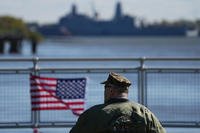The Navy's budget is slated to grow by an astounding $12.6 billion, an increase of seven percent from last year. This figure includes an ample $15 billion war fund, according to a budget request released Monday.
But the much-anticipated ramp up in shipbuilding from roughly 280 battle force ships today to 350 or more has yet to materialize fully in Navy planning.
According to the documents, the Navy is requesting $194.1 billion in total, up from roughly $180 billion in fiscal 2018. Overseas contingency operations, or war, funding is nearly doubled from last year's request of $8.5 billion, a development that planners say reflects deployed Navy and Marine Corps forces operating in Afghanistan and elsewhere in the Middle East.
"For the foreseeable future, the demand for naval presence in theater remains high as we uphold commitments to allies and partner states," the document states.
However, the much-hailed jump-start in Navy shipbuilding to reach the larger fleet officials say the service needs represents only a small portion of the service's requested funding increase.
Shipbuilding funding is slated to rise only $1.9 billion from fiscal 2018 to fiscal 2019, according to the planning document. By fiscal 2023, the latest year for which there are planning figures, shipbuilding spending is expected to total $26 billion.
By 2023, the Navy expects to add 54 new ships, but most of them had already been part of long-term production plans.
For 2019, the plan includes only one more ship than was budgeted in 2018: an additional Arleigh Burke-class destroyer, for a total purchase of three instead of two.
The Navy plans to buy three destroyers every year for the next five years, except for fiscal 2020, when two are planned for purchase.
Purchase of the Virginia-class submarine will remain steady at two per year through fiscal 2023, according to plans, while the Navy plans to buy the first Columbia-class sub in 2021.
Documents also shows the service's plan to begin buying its future frigate, for which a design has yet to be selected.
The Navy expects to buy its last littoral combat ship in 2019 and immediately begin buying the frigate the following year. Documents show plans to buy one frigate per year in 2020 and 2021, and two each in the following two years.
For major shipbuilding, the last big development is the start of the LX(R) program, the next class of amphibious ship. The Navy plans to buy its first on schedule in 2020 and purchase two more by 2023.
These relatively modest numbers do not entirely preclude the kind of shipbuilding ramp-up that the Navy wants to execute.
A December 2017 Congressional Research Service assessment found the service would have to spend an average of $4.6 billion to $5.1 billion per year over the next 30 years to achieve a fleet of 355 ships. Spending is set to exceed that amount by 2023; additional increases could help the Navy reach its stated goal.
The service is also set to add 7,500 sailors as its fleet grows. These additional personnel, which will help the service reach an end strength of 335,400, will provide manning for the new Navy variant of the V-22 Osprey, the CMV-22; a crew for the Navy's newest expeditionary sea base, the Miguel Keith; growth in special operations forces; and continued development of a "blue-and-gold" crewing strategy for the littoral combat ship.
As for what else the Navy's substantial budget request will fund, service planners say priorities include ship depot maintenance, which is requested "at the maximum executed level," totaling $11.9 billion; research, development, test and evaluation, which will grow by nearly $1 billion; and significant plus-ups in aircraft buys.
Procurement of the F-35C Joint Strike Fighter is expected to jump from four planes to nine in 2019 as the Navy nears 2019 initial operational capability for its carrier variant of the aircraft.
Purchase of the F/A-18E/F Super Hornet will also ramp up from 14 to 24 amid Navy efforts to improve aircraft readiness. Reports last year showed major operational shortfalls, with more than half of all Navy Hornets on the flightline unable to fly due to maintenance and budget issues.
Finally, new platforms are coming online: Purchase of the Marines' CH-53K King Stallion will ramp up from four last year to eight this year as the aircraft approaches IOC.
And the Navy plans to purchase six VH-92A helicopters, the planned presidential chopper replacement set to enter service in 2020.
-- Hope Hodge Seck can be reached at hope.seck@military.com. Follow her on Twitter at @HopeSeck.













